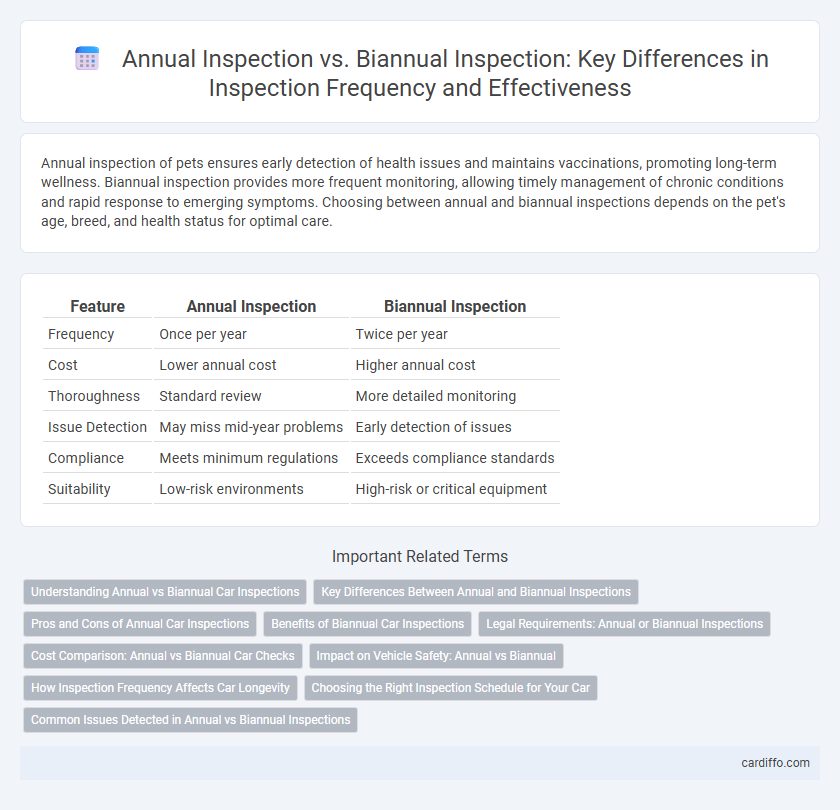Annual inspection of pets ensures early detection of health issues and maintains vaccinations, promoting long-term wellness. Biannual inspection provides more frequent monitoring, allowing timely management of chronic conditions and rapid response to emerging symptoms. Choosing between annual and biannual inspections depends on the pet's age, breed, and health status for optimal care.
Table of Comparison
| Feature | Annual Inspection | Biannual Inspection |
|---|---|---|
| Frequency | Once per year | Twice per year |
| Cost | Lower annual cost | Higher annual cost |
| Thoroughness | Standard review | More detailed monitoring |
| Issue Detection | May miss mid-year problems | Early detection of issues |
| Compliance | Meets minimum regulations | Exceeds compliance standards |
| Suitability | Low-risk environments | High-risk or critical equipment |
Understanding Annual vs Biannual Car Inspections
Annual car inspections typically involve a comprehensive check of safety features, emissions, and engine performance to ensure vehicle compliance with state regulations. Biannual inspections, conducted twice a year, provide more frequent monitoring to detect and address mechanical issues earlier, enhancing vehicle safety and performance. Understanding the differences helps vehicle owners choose the appropriate inspection frequency based on usage, regulatory requirements, and maintenance needs.
Key Differences Between Annual and Biannual Inspections
Annual inspections occur once every 12 months, providing a comprehensive evaluation to ensure ongoing compliance and maintenance of safety standards. Biannual inspections take place twice a year, offering more frequent assessments that help identify potential issues earlier and reduce the risk of equipment failure. The key differences lie in the inspection frequency, early detection capabilities, and overall impact on preventive maintenance strategies.
Pros and Cons of Annual Car Inspections
Annual car inspections provide a comprehensive assessment of vehicle safety and emissions, ensuring compliance with regulatory standards while potentially identifying issues before they escalate. However, the longer interval between inspections may allow some problems to go unnoticed for extended periods, increasing the risk of costly repairs or safety hazards. Although annual inspections are less frequent and more convenient, they may not offer the same level of ongoing vehicle maintenance assurance as biannual inspections.
Benefits of Biannual Car Inspections
Biannual car inspections provide enhanced vehicle safety by identifying potential issues every six months, reducing the risk of unexpected breakdowns and costly repairs. This frequency allows for timely detection of wear and tear on critical components like brakes, tires, and engine parts, ensuring consistent performance and compliance with safety standards. Regular biannual checks also help maintain optimal fuel efficiency and prolong the vehicle's overall lifespan compared to annual inspections.
Legal Requirements: Annual or Biannual Inspections
Legal requirements for inspections vary by industry and jurisdiction, with some regulations mandating annual inspections to ensure ongoing compliance and safety standards. In other cases, biannual inspections are required to provide more frequent monitoring and timely identification of potential issues. Understanding specific legal mandates for annual versus biannual inspections is critical to maintaining regulatory compliance and avoiding penalties.
Cost Comparison: Annual vs Biannual Car Checks
Annual car inspections typically incur lower overall costs compared to biannual inspections due to fewer service appointments and less frequent parts replacement. Biannual inspections may increase expenses by doubling labor fees and diagnostic tests, despite potentially catching issues earlier and reducing costly repairs. Choosing annual inspections often balances cost-effectiveness with adequate vehicle safety and maintenance standards.
Impact on Vehicle Safety: Annual vs Biannual
Annual inspections provide a consistent check to identify potential safety issues and ensure vehicle compliance with regulations, maintaining roadworthiness throughout the year. Biannual inspections offer increased safety assurance by detecting problems more frequently, reducing the risk of undetected mechanical failures. Studies show that vehicles undergoing biannual inspections have lower accident rates due to early fault detection and timely repairs.
How Inspection Frequency Affects Car Longevity
Annual inspections provide a consistent schedule for identifying potential car issues before they escalate, promoting timely maintenance and extending vehicle lifespan. Biannual inspections allow for more frequent monitoring, which can catch wear and tear earlier, reducing the risk of major repairs and enhancing overall durability. Choosing the right inspection frequency directly impacts car longevity by ensuring critical components like brakes, tires, and engine systems remain in optimal condition.
Choosing the Right Inspection Schedule for Your Car
Choosing the right inspection schedule for your car involves evaluating factors such as vehicle age, mileage, and driving conditions. Annual inspections provide thorough checks suited for older cars or high-mileage usage, while biannual inspections can benefit newer vehicles or those driven infrequently. Prioritizing manufacturer recommendations and local regulations ensures optimal vehicle safety and performance.
Common Issues Detected in Annual vs Biannual Inspections
Annual inspections commonly detect wear and tear, corrosion, and outdated safety components, while biannual inspections reveal more progressive issues like structural fatigue, early-stage leaks, and evolving mechanical malfunctions. The increased frequency of biannual inspections allows for earlier identification of developing problems, reducing long-term repair costs and downtime. Both inspection types are critical, but biannual inspections provide a more proactive approach to equipment maintenance and safety assurance.
Annual inspection vs biannual inspection Infographic

 cardiffo.com
cardiffo.com